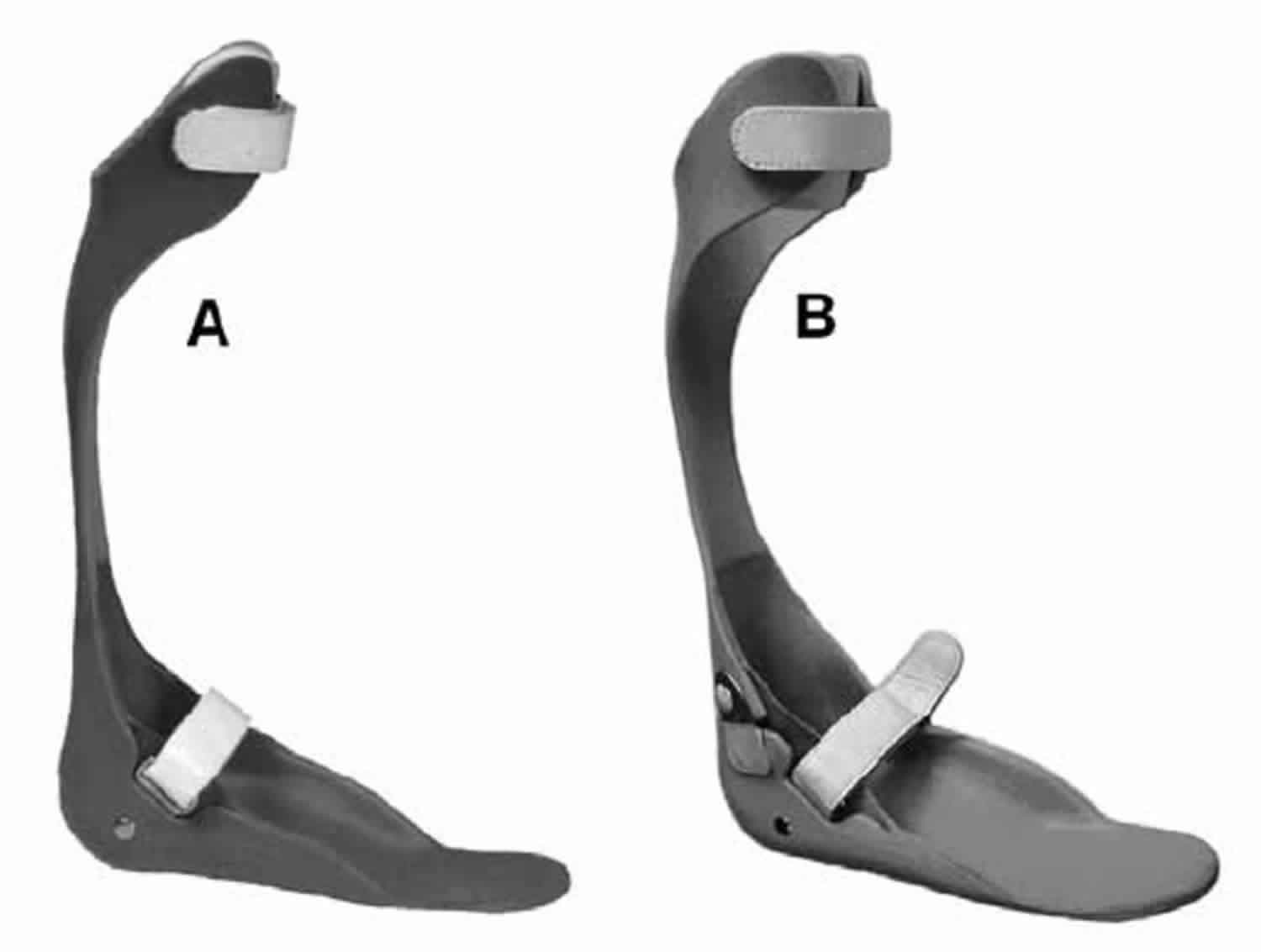What is AFO
AFO is short for ankle-foot orthosis, which is a support to provide direct control of the position and motion of the ankle and foot to improve gait. The goal of AFO use is to stabilize the foot and ankle and provide toe clearance during the swing phase of gait. This helps decrease the risk of catching the toe and falling. AFO compensates for weakness or correct deformities of lower limbs or to position a foot with contracted muscles into a more normal position. In patients with a variety of neurological disorders and musculoskeletal disorders, gait is often limited by a reduced ability to push off with the ankle. To overcome this reduced ankle push-off, energy-storing, spring-like carbon-composite AFO (ankle foot orthosis) can be prescribed 1. It is expected that the energy returned by the AFO in late stance will support ankle push-off, and reduce the energy cost of walking. Due to the common use for addressing foot drop, AFO has become synonymous with the term “foot-drop brace”.
A typical AFO creates an L-shaped frame around the foot and ankle, extending from just below the knee to the metatarsal heads of the foot. AFO’s can be purchased off the shelf or can be custom molded to an individual wearer, and can be fabricated of a variety of materials, including heat-moldable plastics, metal, leather and carbon composite. AFOs are the most commonly used orthoses, making up about 26% of all orthoses provided in the United States.
Ankle-foot orthosis (AFO) is the most frequently used type of orthosis in children with cerebral palsy (CP) 2. AFOs are designed to address two main concerns; either to improve function or to affect the body structure (i.e. to prevent or treat contractures). AFOs have been found to increase walking speed and reduce the energy cost in children with cerebral palsy 3.
Ankle foot orthoses (AFO) are also prescribed to facilitate ankle control in multiple sclerosis and stroke patients with equinus and/or varus foot 4, provide mediolateral stability of the ankle in the stance phase, facilitate gait in the swing phase, and reduce energy expenditure while walking 5. In patients suffering from central neurological disorders, such as multiple sclerosis and stroke, gait is often limited by a reduced ability to push off with the ankle, caused by weakness of the plantar flexor muscles 6.
Carbon-composite ankle foot orthoses (AFOs) can be prescribed to overcome the reduced ankle push-off 7, and to decrease the elevated energy cost of walking 8. These carbon-composite AFOs hold spring-like properties, which potentially enable the storage of energy at the beginning of the stance phase and the return of this energy at the end of the stance phase 7. It is expected that the return of energy in late stance augments the ankle push-off, and consequently reduces the need for inefficient compensation strategies. An AFO seems to exert a positive influence on the joint alignment of the affected lower limb, with improvements in cadence and gait velocity 9.
AFO types
There are 2 types of AFOs (ankle foot orthoses) meet specific needs (Figure 1):
- Solid (i.e. stiff) AFO and
- Hinged AFO to allow for dorsiflexion.
Figure 1. AFO types

Footnote: Two types of ankle foot orthoses (AFOs) with A ) a solid (i.e. stiff) AFO and B ) a hinged AFO to allow for dorsiflexion.
[Source 10 ]Carbon Fiber AFOs
- Dynamic semi-flexible footplate
- Promotes natural gait pattern
- Enhances strength and stability to control torsion forces
Lightweight, modern, low-profile design provides added strength and stability, while avoiding contact at critical pressure points and facilitating a normal walking pattern. Ideal for active clients.
Footplates have 10-15° of forefoot lift beginning around the metatarsal heads, yet still accommodate a foot orthotic. Open heel design helps eliminate pressure sores. Flexible calf and tibial bands accommodate a wide range of calf circumferences. Lateral strut is ideal for patients with medial ankle instability, that evert, pronate, or have valgus. Medial support strut is ideal for patients with lateral ankle instability, that invert, supinate, or have varus.
Swedish AFOs
- Lower profile than traditional plastic AFO
- Enhanced airflow for cool comfort
- Heat-moldable and trimmable for customized fit
Deliver moderate lateral stability and static dorsiflexion assistance in a streamlined design for an easy, comfortable fit. Open calf and heel offers cool comfort and better shoe fit than a traditional plastic AFO. Trimmable footplate helps fit to any shoe. Ideal for a moderately active user.
Traditional Plastic AFOs
- Accommodate a wide variety of needs
- Options for maximum-to-minimum medial/lateral stability
- Heat-moldable for customized fit
- Reliable, economical options to meet a variety of needs. Can be applied in seconds, and easily modified by heat-molding or trimming for optimal customization. An ideal solution for short-term use.
- Spring-like Ankle Foot Orthoses reduce the energy cost of walking by taking over ankle work. Gait & Posture Volume 35, Issue 1, January 2012, Pages 148-153 https://doi.org/10.1016/j.gaitpost.2011.08.026[↩]
- Wingstrand M, Hägglund G, Rodby-Bousquet E. Ankle-foot orthoses in children with cerebral palsy: a cross sectional population based study of 2200 children. BMC Musculoskelet Disord. 2014;15:327. Published 2014 Oct 2. doi:10.1186/1471-2474-15-327 https://www.ncbi.nlm.nih.gov/pmc/articles/PMC4192348[↩]
- Brehm MA, Harlaar J, Schwartz M. Effect of ankle-foot orthoses on walking efficiency and gait in children with cerebral palsy. J Rehabil Med. 2008;40(7):529–534. doi: 10.2340/16501977-0209[↩]
- Kinematic features of rear-foot motion using anterior and posterior ankle-foot orthoses in stroke patients with hemiplegic gait. Chen CC, Hong WH, Wang CM, Chen CK, Wu KP, Kang CF, Tang SF. Arch Phys Med Rehabil. 2010 Dec; 91(12):1862-8.[↩]
- Spring-like Ankle Foot Orthoses reduce the energy cost of walking by taking over ankle work. Bregman DJ, Harlaar J, Meskers CG, de Groot V. Gait Posture. 2012 Jan; 35(1):148-53. https://doi.org/10.1016/j.gaitpost.2011.08.026[↩]
- S. Nadeau, D. Gravel, A.B. Arsenault, D. Bourbonnais. Plantarflexor weakness as a limiting factor of gait speed in stroke subjects and the compensating role of hip flexors. Clin Biomech (Bristol, Avon), 14 (1999), pp. 125-135[↩]
- S.I. Wolf, M. Alimusaj, O. Rettig, L. Doderlein. Dynamic assist by carbon fiber spring AFOs for patients with myelomeningocele. Gait Posture, 28 (2008), pp. 175-177[↩][↩]
- A. Danielsson, K.S. Sunnerhagen. Energy expenditure in stroke subjects walking with a carbon composite ankle foot orthosis. J Rehabil Med, 36 (2004), pp. 165-168[↩]
- Sankaranarayan H, Gupta A, Khanna M, Taly AB, Thennarasu K. Role of ankle foot orthosis in improving locomotion and functional recovery in patients with stroke: A prospective rehabilitation study. J Neurosci Rural Pract. 2016;7(4):544–549. doi:10.4103/0976-3147.185507 https://www.ncbi.nlm.nih.gov/pmc/articles/PMC5006466/[↩]
- Romkes, Jacqueline. (2008). Gait in hemiplegic cerebral palsy : effects of ankle foot orthoses. [↩]




